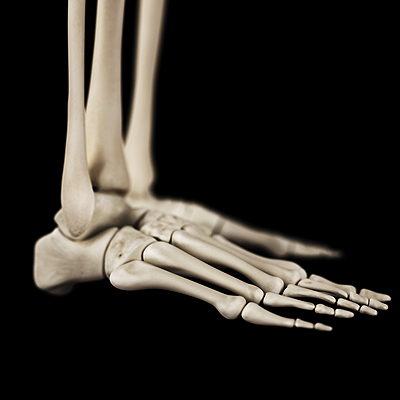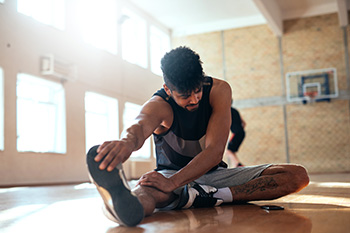Connect With Us
Blog
Items filtered by date: July 2023
Causes of a Stress Fracture

A hairline crack in a foot bone it's also known as a stress fracture. Frequently participating in running and jumping activities may cause stress fractures, which can happen from the repetitive force. A stress fracture can gradually occur, and many people choose to ignore the dull ache that accompanies this injury. When the pain becomes severe medical attention is often sought, and relief tactics are begun. Swelling may accompany a stress fracture, and walking can become difficult. A bone scan or an MRI can be performed to determine the extent of the fracture, as it may not be visible on an X-ray. Additionally, people who have osteoporosis or who consistently run on hard surfaces may be prone to getting a stress fracture. Treatment can begin by temporarily stopping the activity that caused the fracture, and elevating the affected foot may reduce the swelling. It may help to wear a protective boot that can provide the necessary stability as it heals. If you have a stress fracture of the foot, it is suggested that you confer with a podiatrist who can effectively diagnose and treat this condition.
Activities where too much pressure is put on the feet can cause stress fractures. To learn more, contact one of our podiatrists from Tri-Town Podiatry. Our doctors can provide the care you need to keep your pain free and on your feet.
Dealing with Stress Fractures of the Foot and Ankle
Stress fractures occur in the foot and ankle when muscles in these areas weaken from too much or too little use. The feet and ankles then lose support when walking or running from the impact of the ground. Since there is no protection, the bones receive the full impact of each step. Stress on the feet can cause cracks to form in the bones, thus creating stress fractures.
What Are Stress Fractures?
Stress fractures occur frequently in individuals whose daily activities cause great impact on the feet and ankles. Stress factors are most common among:
- Runners
- People affected with Osteoporosis
- Tennis or basketball players
- Gymnasts
- High impact workouts
Symptoms
Pain from the fractures occur in the area of the fractures and can be constant or intermittent. It will often cause sharp or dull pain with swelling and tenderness. Engaging in any kind of activity which involves high impact will aggravate pain.
If you have any questions please feel free to contact our offices located in Arlington, Canton, and Chelsea, MA . We offer the newest diagnostic and treatment technologies for all your foot and ankle needs.
Three Stages of an Ingrown Toenail

An ingrown toenail can be a potentially dangerous foot condition if medical attention is not promptly received. An ingrown toenail occurs when the nail grows into the skin instead of over it. It is a generally painful ailment, and severely ingrown toenails may bleed and become infected. This condition can be divided into three stages of development. The first stage causes mild inflammation, and it is often uncomfortable. A granuloma may form in the second stage, which can become more painful, and produce pus. This granuloma can grow over the nail in the third stage, and the entire toe may become inflamed. The most common cause of developing an ingrown toenail is improper foot care. This can range from wearing shoes that do not fit correctly to trimming the toenails in a curved fashion instead of straight across. If you have an ingrown toenail, it is suggested that you seek counsel from a podiatrist as quickly as possible who can perform minor surgery for permanent relief.
Ingrown toenails can become painful if they are not treated properly. For more information about ingrown toenails, contact one of our podiatrists of Tri-Town Podiatry. Our doctors can provide the care you need to keep you pain-free and on your feet.
Ingrown Toenails
Ingrown toenails occur when a toenail grows sideways into the bed of the nail, causing pain, swelling, and possibly infection.
Causes
- Bacterial infections
- Improper nail cutting such as cutting it too short or not straight across
- Trauma to the toe, such as stubbing, which causes the nail to grow back irregularly
- Ill-fitting shoes that bunch the toes too close together
- Genetic predisposition
Prevention
Because ingrown toenails are not something found outside of shoe-wearing cultures, going barefoot as often as possible will decrease the likeliness of developing ingrown toenails. Wearing proper fitting shoes and using proper cutting techniques will also help decrease your risk of developing ingrown toenails.
Treatment
Ingrown toenails are a very treatable foot condition. In minor cases, soaking the affected area in salt or antibacterial soaps will not only help with the ingrown nail itself, but also help prevent any infections from occurring. In more severe cases, surgery is an option. In either case, speaking to your podiatrist about this condition will help you get a better understanding of specific treatment options that are right for you.
If you have any questions please feel free to contact our offices located in Arlington, Canton, and Chelsea, MA . We offer the newest diagnostic and treatment technologies for all your foot and ankle needs.
See Your Podiatrist Regularly If You Work On Your Feet
Ways to Combat Cracked Heels

Cracked heels, which are a common foot condition, are usually non-threatening but can become potentially serious. It is best to try to prevent cracked heels from developing in the first place. It is a good idea to examine your heels and if they begin to feel dry, apply moisturizer regularly. Also, if you gain weight, the pressure on the heels increases and calluses may form. Extra weight, quite common among pregnant women, expands the heel skin while walking and standing and can cause cracks to widen. Wearing sling-back shoes, sandals, or flip flops also may cause the heels to dry out. Dried and cracked heels also can be a problem for those with diabetes, which can diminish the moisture supply to the feet. If the cracked skin on the heels does not improve with daily foot care precautions, they may deepen into fissures or begin to bleed. This opening of the skin can invite bacterial or fungal infections. An antiseptic lotion may help to keep the area clean. If cracked heels become an ongoing problem, it is suggested that you make an appointment with a podiatrist who can examine the area, and determine the best course of treatment.
If the skin on your feet starts to crack, you may want to see a podiatrist to find treatment. If you have any concerns, contact one of our podiatrists from Tri-Town Podiatry. Our doctors can provide the care you need to keep you pain-free and on your feet.
Cracked Heels
It is important to moisturize your cracked heels in order to prevent pain, bleeding, and infection. The reason cracked heels form is because the skin on the foot is too dry to support the immense pressure placed on them. When the foot expands, the dry skin on the foot begins to split.
Ways to Help Heal Them
- Invest in a good foot cream
- Try Using Petroleum Jelly
- Ease up on Soaps
- Drink Plenty of Water
Ways to Prevent Cracked Heels
- Moisturize After Showering
- Skip a Shower
- Keep Shower Water Lukewarm
- Don’t Scrub Your Feet
If you are unsure how to proceed in treating cracked heels, seek guidance from a podiatrist. Your doctor will help you with any questions or information you may need.
If you have any questions, please feel free to contact our offices located in Arlington, Canton, and Chelsea, MA . We offer the newest diagnostic and treatment technologies for all your foot care needs.
Effective Stretches May Help to Prevent Running Injuries

People who enjoy running are all too familiar with the fear of incurring a running injury. The majority of running injuries can be prevented when simple strategies are implemented. These are the same techniques for all runners, ranging from weekend warriors to people who run several marathons. Research has shown that stretching is an important factor which may help to prevent running injuries. The hip flexor and quad stretch is done by kneeling on one knee on a mat while pulling the tailbone inward, and pushing the hips forward. This stretch will be felt in front of the hip. For people who prefer a deeper stretch, the ankle can be grabbed, and brought close to the glutes. A calf stretch is effective in exercising the heel and sole of the foot. This is performed by standing on a step while lowering the heels one at a time until a gentle stretch is felt. There are additional stretching techniques that can be done which can protect the feet while running. If you would like more information about how to perform these, it is suggested that you consult with a podiatrist.
All runners should take extra precaution when trying to avoid injury. If you have any concerns about your feet, contact one of our podiatrists of Tri-Town Podiatry. Our doctors will treat your foot and ankle needs.
How to Prevent Running Injuries
There are a lot of mistakes a runner can make prior to a workout that can induce injury. A lot of athletes tend to overstretch before running, instead of saving those workouts for a post-run routine. Deep lunges and hand-to-toe hamstring pulls should be performed after a workout instead of during a warmup. Another common mistake is jumping into an intense routine before your body is physically prepared for it. You should try to ease your way into long-distance running instead of forcing yourself to rush into it.
More Tips for Preventing Injury
- Incorporate Strength Training into Workouts - This will help improve the body’s overall athleticism
- Improve and Maintain Your Flexibility – Stretching everyday will help improve overall performance
- “Warm Up” Before Running and “Cool Down” Afterward – A warm up of 5-10 minutes helps get rid of lactic acid in the muscles and prevents delayed muscle soreness
- Cross-Training is Crucial
- Wear Proper Running Shoes
- Have a Formal Gait Analysis – Poor biomechanics can easily cause injury
If you have any questions, please feel free to contact our offices located in Arlington, Canton, and Chelsea, MA . We offer the newest diagnostic and treatment technologies for all your foot care needs.

